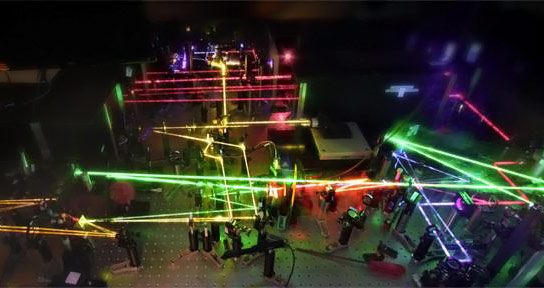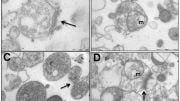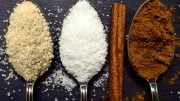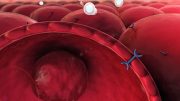
The laser set-up in the lab led to the research results. Credit: Dr Akshay Rao
In a newly published study, researchers detail how manipulating the ‘spin’ of electrons in organic solar cells dramatically improves their performance, providing a vital breakthrough in the pursuit of cheap, high performing solar power technologies.
Organic solar cells, a new class of solar cells that mimics the natural process of plant photosynthesis, could revolutionize renewable energy – but currently lack the efficiency to compete with the more costly commercial silicon cells.
At the moment, organic solar cells can achieve as much as 12 percent efficiency in turning light into electricity, compared with 20 to 25 percent for silicon-based cells.
Now, researchers have discovered that manipulating the ‘spin’ of electrons in these solar cells dramatically improves their performance, providing a vital breakthrough in the pursuit of cheap, high performing solar power technologies.
The study, by researchers from the Universities of Cambridge and Washington, is published today in the journal Nature, and comes just days after scientists called on governments around the world to focus on solar energy with the same drive that put a man on the moon, calling for a “new Apollo mission to harness the sun’s power”.
Organic solar cells replicate photosynthesis using large, carbon-based molecules to harvest sunlight instead of the inorganic semiconductors used in commercial, silicon-based solar cells. These organic cells can be very thin, light and highly flexible, as well as printed from inks similar to newspapers – allowing for much faster and cheaper production processes than current solar cells.
But consistency has been a major issue. Scientists have, until now, struggled to understand why some of the molecules worked unexpectedly well, while others performed indifferently.
Researchers from Cambridge’s Cavendish Laboratory developed sensitive laser-based techniques to track the motion and interaction of electrons in these cells. To their surprise, the team found that the performance differences between materials could be attributed to the quantum property of ‘spin’.
‘Spin’ is a property of particles related to their angular momentum, with electrons coming in two flavors, ‘spin-up’ or ‘spin-down’. Electrons in solar cells can be lost through a process called ‘recombination’, where electrons lose their energy – or “excitation” state – and fall back into an empty state known as the “hole”.
Researchers found that by arranging the electrons ‘spin’ in a specific way, they can block the energy collapse from ‘recombination’ and increase current from the cell.
“This discovery is very exciting, as we can now harness spin physics to improve solar cells, something we had previously not thought possible. We should see new materials and solar cells that make use of this very soon” said Dr. Akshay Rao, a Research Fellow at the Cavendish Laboratory and Corpus Christi College, Cambridge, who lead the study with colleagues Philip Chow and Dr. Simon Gélinas.
The Cambridge team believe that design concepts coming out of this work could help to close the gap between organic and silicon solar cells, bringing the large-scale deployment of solar cells closer to reality. In addition, some of these design concepts could also be applied to Organic Light Emitting diodes, a new and rapidly growing display technology, allowing for more efficient displays in cell phones and TVs.
“The laser technique we used makes ultrafast movies at approximately one million billion frames per second, allowing us to monitor what happens from the moment the light is absorbed in the device until electrical current comes out,” added Gélinas. “Through this, we’ve identified what mechanisms prevent the loss of electrical current in good organic solar cells.
“Now we can design materials knowing specifically how to harvest the most out of this process.”
The work on solar cells at Cambridge forms part of a broader initiative to harness high-tech knowledge in the physics sciences to tackle global challenges such as climate change and renewable energy. This initiative is backed by both the UK Engineering and Physical Sciences Research Council and, in Cambridge, the Winton Program for the Physics of Sustainability. The work at the University of Washington was supported by the US National Science Foundation and the U.S. Office of Naval Research
Reference: “The role of spin in the kinetic control of recombination in organic photovoltaics” by Akshay Rao, Philip C. Y. Chow, Simon Gélinas, Cody W. Schlenker, Chang-Zhi Li, Hin-Lap Yip, Alex K.-Y. Jen, David S. Ginger and Richard H. Friend, 7 August 2013, Nature.
DOI: 10.1038/nature12339
arXiv:1303.2821









This sounds as if it could be great, but it also sounds a bit hyped because no quantification is provided by the scientists.
Please give readers some sort of idea as to what you mean by “dramatically improves their performance.” How dramatic? Give the readers some numbers. I noticed the abstract also gives no indication as to what is really meant by dramatic.
I’ve added a link to a PDF copy of the study so you can see the numbers. Thanks-